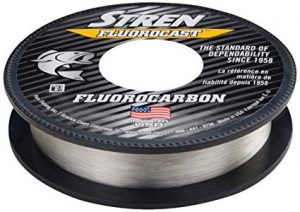Determining What Line To Use
 Which type of salmon fishing line you use on your fishing trip will often mean the difference between a successful day and one filled with a lot of snags, rats-nests and frustration.
Which type of salmon fishing line you use on your fishing trip will often mean the difference between a successful day and one filled with a lot of snags, rats-nests and frustration.
The right salmon fishing line will often be determined by the type of salmon you are going to be targeting during the day; there are specialty lines designed specifically for certain types of fishing conditions, and even standard lines will have varying results depending on the water you are fishing in.
MonoFluoroCarbo What? Help Is Here!
First of all, it is important to understand the different construction materials used in different types of line. Species, depth of presentation, type of lure, size of lure all have a bearing on what type of materials you should be using. If you intend on trolling a spoon or heavier lure’s you want to have a line with some give so you don’t rip the lure out of the Salmons mouth and damage it.
Monofilament has always been, and continues to be, the most popular choice among all anglers (those fishing for salmon included), at least as far as the bulk of purchases. Despite the steady sales in monofilament line, most people who fish will tell you that monofilament remains popular only because it is cheaper than other materials; one strand is not difficult to manufacture. A much more desirable type of salmon fishing line is that made from fluorocarbon.
Fluorocarbon line is much stronger than nylon monofilament due to its complex structure (it is also often used in combination with copolymers). Most importantly to salmon fishers, especially those mooching or drift fishing, is the fact that fluorocarbon reflects light in much the same way as water, and is therefore much more difficult for a salmon to see. This is particularly important when considering leader material for your set up.
Super Lines For Super Salmon
Super lines and specialty lines are made up of different materials and combinations of materials than standard lines. Super lines are designed for strength, and are made through braiding the strands of material or through thermal fusion. They are popular for their amazing strength, knot tying strength and lack of stretch (about 5% opposed to monofilament which is about 20%).
Super lines are most effective when landing huge Chinook, and trolling because of their diameter. The diameter (or thickness) of the line is a fraction of a monofilament line which allows for a quick, deep descent when trolling.
Super lines do not always make the best leader material however, as they are not made of any type of “clear” smooth material. Another point to note is because of the “texture” of the line and lack of smoothness, it can fray and snap if the eyelets of your rod have any type of bur in them, so keep your eyelets filed if you have burs and find a rod that has good guides or eyelets to avoid this problem.
Isn’t That Special!
Specialty lines are also often used when fly fishing for salmon both from in saltwater and freshwater situations. Wire lines are effective leaders when trying to land a sturgeon but have been used on other Pacific species in fast muddy water; the teeth on spawning salmon are greatly enhanced and the wire will prevent them from scraping the line. Wire leaders are not recommended for recreational salmon fishing but serve their purpose in angling other fish.
Specialty lines such as floating fly lines will be of great assistance in set ups for land locked Atlantics and Kokanee; a heavy nymph attached to a floating line will stimulate the instincts of the prey perfectly enough to entice any wary salmon. Specialty fly lines will always be attached to a spool of backing at the end of the rod, which will be necessary when you hook a runner, and is similar to super line in texture and appearance.
Wind It Up!
Every fisher eventually runs the line on the reel down, and it becomes necessary to put some more on the reel before the next trip out. Line winders are integral to this process, as they get the line on the reel efficiently and accurately without a lot of extra work on the part of the fisher. Winders can fit right on a boat, which can be pretty important when you are having a day where the fish just seem to have nothing but fight (“dare to dream Arnold….dare to dream”).
Tip: at the end of each season spool your salmon fishing line onto another vacant spool (preferably something large) using an electric drill to do the work if you don’t have a winder. This will help the line with “memory” so that it’s not all coiled up and easy to work with for the next season.
Also if you do this you can usually get another season out of your line because when you spool it back onto your reel, it will be going on backwards. In other words, the line you’ll be using will probably be untouched line that was always spooled up on the reel and never cast or run!
Here are a couple of links that will give you some general tips on fishing line. If you want to learn more about these lines for the purpose of Salmon fishing, however, continue with the links on the upper right menu. You can find out more about things like monofilament line for Salmon fishing on these pages, which is a very popular line among Salmon anglers.
Tight lines!!!
